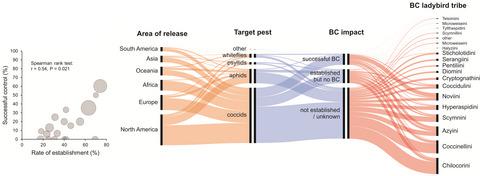当前位置:
X-MOL 学术
›
Entomol. Exp. Appl.
›
论文详情
Our official English website, www.x-mol.net, welcomes your feedback! (Note: you will need to create a separate account there.)
Exotic ladybirds for biological control of herbivorous insects ‐ a review
Entomologia Experimentalis et Applicata ( IF 1.9 ) Pub Date : 2020-09-11 , DOI: 10.1111/eea.12963 Gabriele Rondoni 1 , Isabel Borges 2 , Jana Collatz 3 , Eric Conti 1 , Alejandro C. Costamagna 4 , François Dumont 5 , Edward W. Evans 6 , Audrey A. Grez 7 , Andy G. Howe 8 , Eric Lucas 9 , Julie‐Éléonore Maisonhaute 10 , António Onofre Soares 2 , Tania Zaviezo 11 , Matthew J.W. Cock 12
Entomologia Experimentalis et Applicata ( IF 1.9 ) Pub Date : 2020-09-11 , DOI: 10.1111/eea.12963 Gabriele Rondoni 1 , Isabel Borges 2 , Jana Collatz 3 , Eric Conti 1 , Alejandro C. Costamagna 4 , François Dumont 5 , Edward W. Evans 6 , Audrey A. Grez 7 , Andy G. Howe 8 , Eric Lucas 9 , Julie‐Éléonore Maisonhaute 10 , António Onofre Soares 2 , Tania Zaviezo 11 , Matthew J.W. Cock 12
Affiliation

|
Since the late 19th century, exotic ladybirds (Coleoptera: Coccinellidae) have been used extensively for suppressing herbivorous insects of economic importance. In recent decades, the introduction of non‐native biological control (BC) agents has been greatly limited due to the awareness of the potential non‐target effects of introductions. Nonetheless, recent episodes of biological invasions of economically important pests have raised the need to carefully consider whether the expected benefits of pest control go beyond the possible environmental risks of introduction. To better understand the factors that contributed to successful BC programs, here we review the literature behind classical and augmentative BC using exotic ladybirds. Additionally, by means of case studies, we discuss the BC efficacy of selected exotic species, e.g., Coccinella septempunctata L., Harmonia axyridis (Pallas), and Hippodamia variegata (Goeze), and their position within the communities of predators in the introduced areas of USA, Canada, and Chile. In Europe, much of the research on exotic ladybirds has been conducted on the undesired impact of H. axyridis. Therefore, we summarize the risk assessment data for this species and review the field research investigating the ecological impact on European aphidophagous predators. According to the BIOCAT database of classical BC programs, 212 ladybird species belonging to 68 genera have been released in about 130 years of BC activity, with 14.6% of introductions having resulted in partial, substantial, or complete control of the target pest. However, because post‐release evaluation of establishment and BC success has not always been conducted, this rate could underestimate the successful cases. Among other factors, ladybird establishment and pest suppression mostly depend on (1) intrinsic factors, i.e., high voracity, synchronized predator‐prey life cycle, and high dispersal ability, and (2) extrinsic factors, i.e., adaptability to the new environment and landscape composition. This review contributes to improved understanding of ladybirds as exotic BC agents.
中文翻译:

用于草食性昆虫生物防治的外来瓢虫——综述
自 19 世纪后期以来,外来瓢虫(鞘翅目:瓢虫科)已被广泛用于抑制具有经济重要性的食草昆虫。近几十年来,由于意识到引入的潜在非目标效应,非天然生物防治 (BC) 剂的引入受到很大限制。尽管如此,最近发生的具有重要经济意义的害虫的生物入侵事件已经提出需要仔细考虑害虫防治的预期收益是否超出了引入可能带来的环境风险。为了更好地理解促成成功的 BC 计划的因素,我们在这里回顾了使用异国情调的瓢虫的经典和增强 BC 背后的文献。此外,通过案例研究,我们讨论了选定外来物种的 BC 功效,例如,Coccinella septempunctata L.、Harmonia axyridis (Pallas) 和 Hippodamia variegata (Goeze),以及它们在美国、加拿大和智利引进地区的捕食者群落中的位置。在欧洲,对异国瓢虫的大部分研究都是针对瓢虫的不良影响进行的。因此,我们总结了该物种的风险评估数据,并回顾了调查对欧洲蚜虫捕食者生态影响的实地研究。根据经典 BC 程序的 BIOCAT 数据库,在 BC 活动的大约 130 年中,属于 68 属的 212 种瓢虫物种被释放,其中 14.6% 的引入导致部分、大量或完全控制目标害虫。然而,由于并非总是对建立和 BC 成功进行发布后评估,这个比率可能低估了成功案例。除其他因素外,瓢虫的建立和害虫抑制主要取决于(1)内在因素,即高贪婪、同步的捕食者-猎物生命周期和高扩散能力,以及(2)外在因素,即对新环境的适应性和景观构成。这篇综述有助于提高对瓢虫作为外来 BC 代理的理解。
更新日期:2020-09-11
中文翻译:

用于草食性昆虫生物防治的外来瓢虫——综述
自 19 世纪后期以来,外来瓢虫(鞘翅目:瓢虫科)已被广泛用于抑制具有经济重要性的食草昆虫。近几十年来,由于意识到引入的潜在非目标效应,非天然生物防治 (BC) 剂的引入受到很大限制。尽管如此,最近发生的具有重要经济意义的害虫的生物入侵事件已经提出需要仔细考虑害虫防治的预期收益是否超出了引入可能带来的环境风险。为了更好地理解促成成功的 BC 计划的因素,我们在这里回顾了使用异国情调的瓢虫的经典和增强 BC 背后的文献。此外,通过案例研究,我们讨论了选定外来物种的 BC 功效,例如,Coccinella septempunctata L.、Harmonia axyridis (Pallas) 和 Hippodamia variegata (Goeze),以及它们在美国、加拿大和智利引进地区的捕食者群落中的位置。在欧洲,对异国瓢虫的大部分研究都是针对瓢虫的不良影响进行的。因此,我们总结了该物种的风险评估数据,并回顾了调查对欧洲蚜虫捕食者生态影响的实地研究。根据经典 BC 程序的 BIOCAT 数据库,在 BC 活动的大约 130 年中,属于 68 属的 212 种瓢虫物种被释放,其中 14.6% 的引入导致部分、大量或完全控制目标害虫。然而,由于并非总是对建立和 BC 成功进行发布后评估,这个比率可能低估了成功案例。除其他因素外,瓢虫的建立和害虫抑制主要取决于(1)内在因素,即高贪婪、同步的捕食者-猎物生命周期和高扩散能力,以及(2)外在因素,即对新环境的适应性和景观构成。这篇综述有助于提高对瓢虫作为外来 BC 代理的理解。


























 京公网安备 11010802027423号
京公网安备 11010802027423号